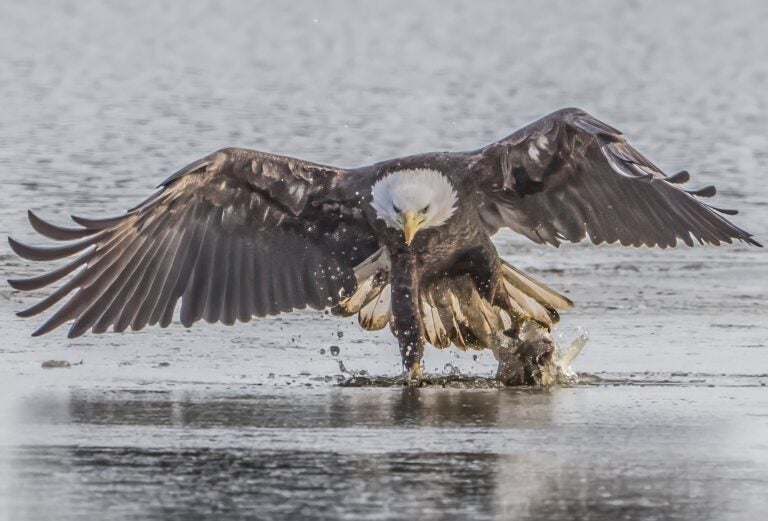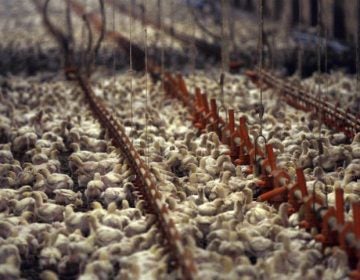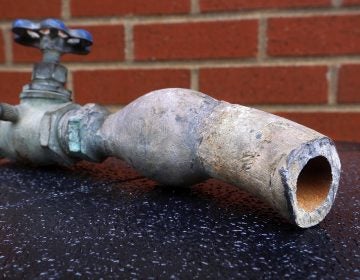New Jersey removes bald eagles from endangered species list as populations soar
The state was able to delist the species because their reproductive rate over multiple years reached sustainable levels.
Listen 1:12
New Jersey has removed the bald eagle from the state's endangered species list. The move comes more than 17 years after the bird was removed from the federal list. (Courtesy of Rich Nicol)
This story is part of the WHYY News Climate Desk, bringing you news and solutions for our changing region.
From the Poconos to the Jersey Shore to the mouth of the Delaware Bay, what do you want to know about climate change? What would you like us to cover? Get in touch.
In the early 1980s, New Jersey was on the brink of losing its last remaining bald eagles. Only one nesting pair existed in the state, and their eggs weren’t hatching because of the lingering effects of the insecticide DDT, which was banned in 1972.
Following decades of restoration work, bald eagles now nest in every New Jersey county. This week, the state removed the bald eagle off its endangered species list — more than 17 years after the majestic bird was federally delisted.
“I’ve been around a long time and have not seen very many species delisted. So, it really is a very special thing,” said Kathy Clark, chief of the endangered and nongame species program at New Jersey Fish and Wildlife.
In 2024, New Jersey surveyed a record 293 nesting pairs of bald eagles, of which 264 laid eggs. Their highest numbers are found along the Delaware Bay, where protected marshlands and coastal creeks provide ideal habitats. The state was able to delist the species because their reproductive rate over multiple years reached sustainable levels.
The success story follows years of artificially incubating eggs, introducing eagle chicks from Canada, monitoring nests and educating the public.
“What this really shows is that big picture conservation is possible. It starts with an inspirational spark that causes a wide swath of people to care deeply, and then the work requires learning, effort and perseverance over the long term,” said Alex Ireland, president and CEO of the environmental group New Jersey Audubon. “It’s very important that we think about this proactively as we go forward. It is much better to conserve species before listing is ever required.”
Following the nationwide recovery of the bald eagle, starting in the Chesapeake Bay, the U.S. Fish and Wildlife Service delisted the predatory bird in 2007.
The national ban on DDT, as well as policies aiming to protect birds of prey, played a role in the eagles’ recovery, said Jason Weckstein, an ornithologist at the Academy of Natural Sciences of Drexel University.
“Eagles are an amazing success story. They went from being pretty rare — it was not something that you saw in the suburbs — and now, here in my neighborhood in Wynnewood, I see bald eagles all the time,” he said. “Look up, because there’s a good chance you’ll be able to see an eagle.”
However, several states did not immediately remove bald eagles from their own endangered species lists. For example, Pennsylvania made the move in 2014.
Clark said bald eagles in New Jersey were slower to recover because DDT use, particularly in South Jersey, was much higher than any other state. The insecticide, which was primarily used to control mosquitos, accumulates in fish that eagles eat, and causes eagles to lay thin-shelled eggs that can’t withstand incubation.
Bald eagles aren’t the only species of bird starting to thrive in New Jersey. Ospreys, also known as “fish hawks,” were removed from the state’s endangered species list this week.
The birds, which typically live along the coast, were threatened by DDT and tree loss caused by development. As a response, the state relocated their eggs to areas with fewer insecticide use, and built nesting platforms that substitute trees. In 2023, the state recorded 800 occupied osprey nests.
Bald eagles and osprey continue to face threats however, including habitat loss, vehicle strikes and avian influenza. Clark said the state will continue to monitor the health of bird populations.
“You never really walk away feeling like you can’t worry about things. There’s plenty of threats out there in the environment,” she said. “People feel very strongly about protecting bald eagles and ospreys in New Jersey, which we’re really grateful for, and that’s why I think that we’ll be in a good place.”
There are several state and federal wildlife laws that continue to protect bald eagles and ospreys, and their nests.
Drexel’s Weckstein said while much progress has been made, it’s crucial state and federal agencies protect wildlife from future threats, such as new types of insecticides or toxic chemicals.
“We should learn our lesson and keep on studying these new things that we use and make sure that they really are safe for our native wildlife,” he said. “We remove one pesticide, but we add a new one. We need to make sure that we’re not doing things that are affecting these organisms.”
New Jersey residents and visitors can report sightings of endangered species by using the state’s Wildlife Tracker.

Get daily updates from WHYY News!
WHYY is your source for fact-based, in-depth journalism and information. As a nonprofit organization, we rely on financial support from readers like you. Please give today.






